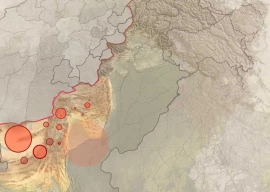
The issue is never far from the political agenda. However, it has been particularly highlighted over the last week by changes in America. John Brennan, US President Barack Obama’s top counterterrorism adviser and nominee for director of the CIA, is an avid supporter of the US drone programme, which covers Yemen and Somalia as well as Pakistan. His Senate confirmation hearing in Washington on February 7 was interrupted by anti-drone protesters. Brennan used the interruption as part of his defence of drones, claiming that protesters simply didn’t understand how much care the US takes over the strikes. It was in keeping with the tone of the event. The chair of the committee, Democrat Senator Dianne Feinstein, repeated the White House line that the number of civilian casualties caused by US drone strikes each year has “typically been in the single digits”.
There is no doubt that this is a drastic underestimation, to say the least. But what is the real fallout? In the shadowy world of covert warfare — not to mention the difficulty of monitoring a terrain such as Waziristan — definitive numbers are hard to come by. Several organisations have made serious attempts to collate figures. The London-based Bureau of Investigative Journalism has an on-going project looking at the numbers of people killed. It estimates that since 2004, there have been 330 US drone strikes (278 of them under Obama) in Pakistan, that have so far killed at least 2,500 people. At least 482 civilians are credibly reported among the dead. The Washington-based New America Foundation also keeps a tally, which shows that civilian killings have been in double-digits every year since 2004, except for 2012. While the deaths of top Taliban commanders are held up as justification for the programme, a joint study by Stanford Law School and New York University’s School of Law last year found that these ‘high-level’ targets account for just two per cent of the total casualties.
Those are the numbers. There is also the human cost. Clive Stafford Smith, the head of legal charity Reprieve which has been active in protesting against drone warfare, told me that there has been a substantial increase in prescriptions of anti-depressants in Waziristan. The constant fear of death, the 24 hour buzzing of ‘bees’ overhead, is having a serious effect on the mental health of the 800,000 residents of the province. The Stanford/NYU report said that the presence of drones “terrorises men, women and children, giving rise to anxiety and psychological trauma among civilian communities. Those living under drones have to face the constant worry that a deadly strike may be fired at any moment, and the knowledge that they are powerless to protect themselves.” As a result, many avoid gathering in groups out of fear they may attract the attention of drone operators sitting in Nevada and pressing buttons. These group gatherings include jirgas, dispute resolutions, funerals and weddings. Many children have dropped out of school, injured or traumatised by strikes. The report called for an urgent reconsideration of the policy, but with its immense popularity among the US public (who prefer drones to ground assaults), and support among the highest echelons of the Obama administration, this does not look likely.
It is indisputable that there is a negative knock-on effect. Anecdotal evidence of drone strikes pushing civilians towards terrorism abounds. Several counter-terrorism activists working in Khyber-Pakhtunkhwa that I have spoken to strongly believe that the policy alienates the local population and encourages already disenfranchised boys to give themselves over to militancy. A kidnap victim I interviewed last year, who was held in Waziristan for several months, told me that he believes drones fuel anger and alienation in these marginalised areas. Certainly, anti-Americanism among the wider population is increasing. The Pew Global Survey found that 74 per cent of Pakistanis viewed Americans as the enemy in 2012, as opposed to 64 per cent in 2009.
Yet while awareness of drones may be on the up, there are tentative signs that the situation could be improving. According to the Bureau of Investigative Journalism, civilian deaths in Pakistan fell from a peak of 119 in 2009 to 68 in 2011 and seven in 2012. The New America Foundation’s records for last year find a similar figure of five civilian deaths, and its numbers suggest that the number of non-militants dying in attacks has reduced since 2006. If the US government and people like John Brennan were to be believed, this is the result of increasing accuracy of drone strikes. This may be partially true, but Omar Shakir, joint author of the Stanford/NYU report, suggests caution. He says that the scarcity of reliable information means that the apparently reduced number of civilian casualties in Waziristan could just be evidence of drone activity switching from Pakistan to other regions, such as Yemen.
Drones are not going to go away and they are not going to stop being controversial. Last week, Sherry Rehman, Pakistan’s ambassador to the US, said that the programme was illegal and violated Pakistan’s sovereignty. She also denied that the Pakistani government is complicit: “There is no policy of quiet complacency, no wink and nod.” Questions over the human rights implications, cooperation from the state and alternatives for fighting terrorism, are all set to be key issues for public debate over the election period. And as the issue is debated, those operators in Nevada will keep pressing the buttons that wreak devastation thousands of miles away. Of that much, we can be sure.
Published in The Express Tribune, February 11th, 2013.










1728386780-0/BeFunky-collage-(38)1728386780-0-270x192.webp)

COMMENTS
Comments are moderated and generally will be posted if they are on-topic and not abusive.
For more information, please see our Comments FAQ